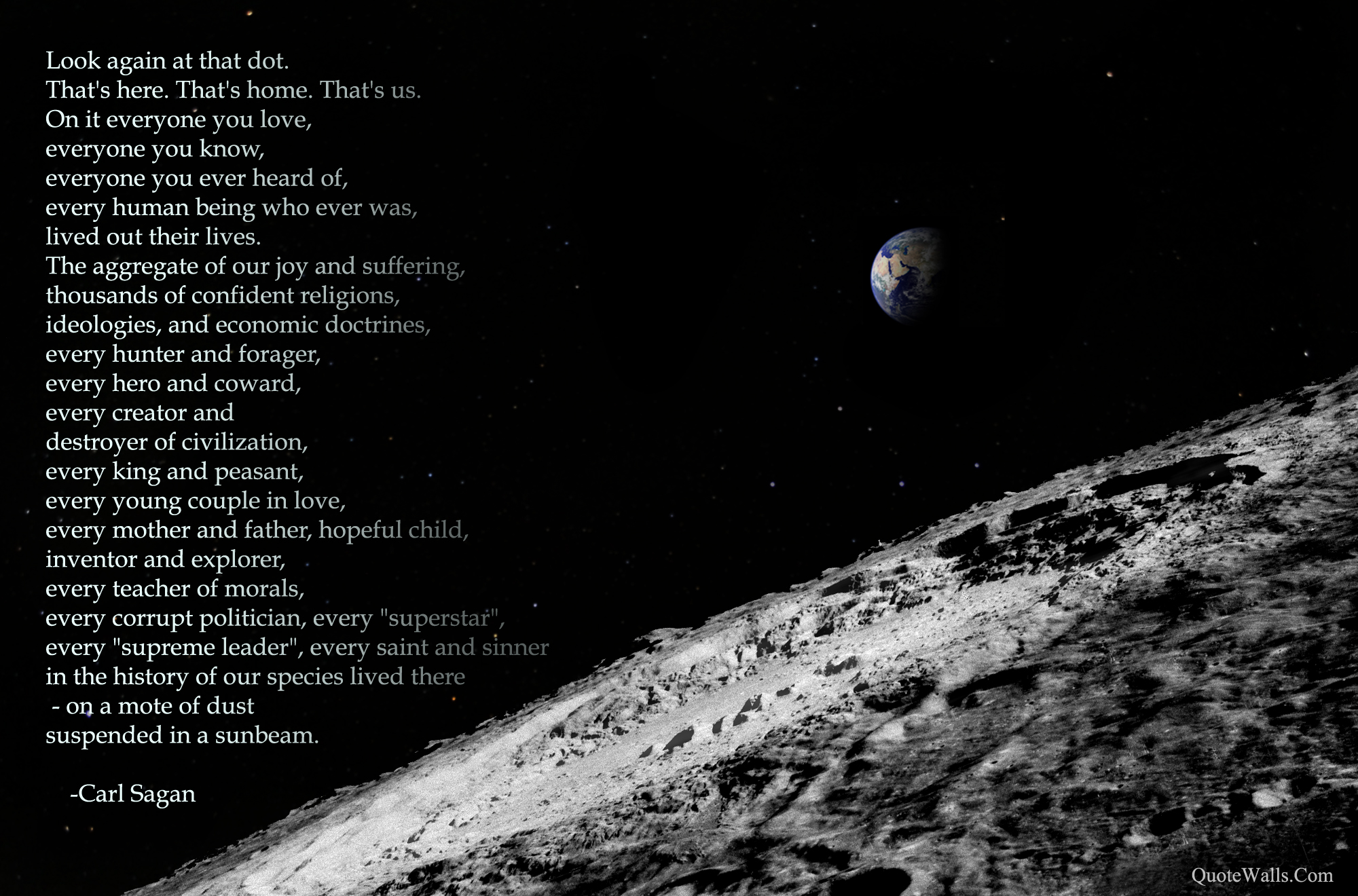Stream Carl Sagan You Are Here (Pale Blue Dot) [Sagan Time by pmylund from desktop or your mobile device Early life and education. Carl Sagan was born in Brooklyn, New York. His father, Samuel Sagan, was an immigrant garment worker from KamianetsPodilskyi, then in the Russian Empire, in today's Ukraine. His mother, Rachel Molly Gruber, was a housewife from New York. A Pale Blue Dot This excerpt from Sagan's book Pale Blue Dot was inspired by an image taken, at Sagan's suggestion, by Voyager 1 on February 14, 1990. As the spacecraft left our planetary neighborhood for the fringes of the solar system, engineers turned it. In Pale Blue Dot Sagan traces the spellbinding history of our launch into the cosmos and assesses the future that looms before us as we move out into our own solar system and on to distant galaxies beyond. Sign in now to see your channels and recommendations! Watch Queue Queue Check out this Carl Sagan Pale Blue Dot quote from his book Pale Blue Dot: A Vision of the Human Future in Space: Look again at that dot. Carl Sagan, Pale Blue Dot: A Vision of the Human Future in Space, (New York: Ballantine Books, 1994). Pale Blue Dot was published in 1994, four years after Carl Sagan convinced NASA to turn the Voyagers cameras back at earth and take a picture of its long traveled path. Pale Blue Dot was Carl's last book, written while he was battling cancer and published after his death. Sagan was responsible for having NASA rotate a Voyager spacecraft (as it was leaving the solar system) and photograph the planets, including of course the Earth, which was appeared as a. and underscores our responsibility and to preserve and cherish the pale blue dot. Submit Corrections Writer(s): DAN MARSALA, CARL SAGAN, RYAN PHILLIPS. The Pale Blue Dot is a photograph of Earth (click here to see it) taken by the Voyager 1 spacecraft at a distance of 3. The spacecraft had completed its primary mission and was passing Saturn, hurtling through space at 40, 000 mph. Carl Sagan requested that the spacecraft turn. In Pale Blue Dot Sagan traces the spellbinding history of our launch into the cosmos and assesses the future that looms before us as we move out into our own solar system and on to distant galaxies beyond. Pale Blue Dot Carl Sagan Quote Limited Time: Free Offer! PIA This narrowangle color image of the Earth, dubbed 'Pale Blue Dot is a part of the first ever 'portrait' of the solar system taken by Voyager 1. The spacecraft acquired a total of 60 frames for a mosaic of the solar system from a distance of. Brief audio recording of Carl Sagan describing the primary concept of his book Pale blue dot: a vision of the human future in space. In reflecting on the image of the Earth as a tiny speak he notes that's us that the Earth is a mote of dust, suspended in a sun beam' and a very small stage in. Pale Blue Dot is a nonfiction and is Sagans analysis of the role space will play in humanitys future. It was written in 1994, and therefore one of his last publications, as Sagan tragically died in 1996. Carl Edward Sagan is an American scientist, astronomer, cosmologist, astrophysicist, astrobiologist, and author. He inspires us because he helps us to consider our position in the universe. A facilitator training session we always come back to explores the photograph, Pale Blue Dot. Pale Blue Dot: A Vision of the Human Future in Space by Sagan, Carl and a great selection of similar Used, New and Collectible Books available now at AbeBooks. Pale Blue Dot: A Vision of the Human Future in Space by Sagan, Carl A copy that has been read, but remains in clean condition. All pages are intact, and the cover is intact. The Pale Blue Dot: A vision of the human future. Carl Sagan Neil deGrasse Tyson Duration: 4: 22. Richard vWyk 68, 922 views CARL SAGAN PALE BLUE DOT A V I S I O N O F T H E H U M A N F U T UR E I N S PA C E F O R S A M Another wanderer, May your generation see Wonders undreamt. 2 SPACECRAFT EXPLORATION OF THE SOLAR SYSTEM NOTABLE EARLY ACHIEVEMENTS UNITED STATES 1958 First scientific discovery in spaceVan Allen radiation belt. Carl Sagan, Pale Blue Dot: A Vision of the Human Future in Space. tags: engineering, exploration, rolemodels, science, scientists, space. Like It has been said that astronomy is a humbling and characterbuilding experience. There is perhaps no better demonstration of the folly of human conceits than this distant image of our. There is something about Carl Sagan's famous Pale Blue Dot passage that is, to me at least, perfect. From this distant vantage point, the Earth might not seem of any particular interest. Carl Sagan: Narozen Na Cosmos Sagan navzal knihou Pale Blue Dot: A Vision of the Human Future in Space, je americk denk The New York Times oznail za vznamn dlo roku 1995. Rovn napsal pedmluvu k velespn knize Stephena Hawkinga Strun historie asu. Author Carl Sagan Biography: Carl Sagan ( ) was the Director of Cornell Universitys Laboratory for Planetary Studies. He played a leading role in the American space program and was an adviser to NASA since its inception. Carl Sagan author of A Pale Blue Dot; The DemonHaunted World, Contact, Cosmos We succeeded in taking that picture [from deep space, and, if you Carl Sagans Pale Blue Dot March 17, 2015 Sagan Carl John Messerly This multimedia presentation was reprinted in the online magazine of the Institute for Ethics. The Pale Blue Dot by Carl Sagan. If it were in my power, every person on the planet would read this. Earth as seen from the Voyager spacecraft from 3. Life on the Pale Blue Dot Carl Edward Sagan was born Nov. He attended college at the University of Chicago, where he attained a Ph. As NASA's Voyager 1 spacecraft was about to leave our Solar System in 1989, Sagan, who was a member of the mission's imaging team, pleaded with officials to turn the camera around to take one last. Carl Sagan was what every science nerd aspires to be. He was an astronomer, astrobiologist, physicist, cosmologist, author, educator, sometimes philosopher, and advocate of human space travel. The McMahan Photo Art Gallery Archive NASA Voyager 1 Earth Pale Blue Dot 30x40 Silver Halide Photo Print by The McMahan Photo Art Gallery Archive 139. 99 139 99 On December 6, 1994, Carl Sagan, author of Cosmos, wellknown astronomer and speaker, appeared before the Commonwealth Club of California in San Francisco to introduce his new book, Pale Blue Dot. Earlier in the day I had the opportunity to briefly talk with him during a break in presentations at the fall meeting of the American Geophysical Union. Buch und berlegungen von Carl Sagan Das Bild inspirierte Sagan zu seinem Buch Pale Blue Dot: A Vision of the Human Future in Space [7 (deutscher Titel: Blauer Punkt im All. Pale Blue Dot, by Carl Sagan Look again at that dot. On it everyone you love, everyone you know, everyone you ever heard of. Pale Blue Dot: a Vision of the Human Future in Space by Carl Sagan, , available at Book Depository with free delivery worldwide. Carl Sagan's timeless Pale Blue Dot speech is the best way to set perspective. The Voyager 1 space probe took the famous photo from 3. Brain Pickings remains free (and adfree) and takes me hundreds of hours a month to research and write, An Animated Adaptation of Carl Sagans Pale Blue Dot The Pale Blue Dot: A Timeless Valentine to the Cosmos Stardust: A Mesmerizing Short Film About the Voyager 1 and the Wonder of the Universe. Pale Blue Dot: A Vision of the Human Future in Space is a 1994 book by Carl Sagan. It is the sequel to Cosmos and was inspired by the famous Pale Blue Dot photograph, for which Sagan provides a poignant description. In this book, Sagan mixes philosophy about the human place in the universe with a description of the current knowledge about the Solar System. The Pale Blue Dot is a photograph of the earth taken from the Voyager Space Craft in 1990 from 6 billion kilometres away. This iconic image was taken at the request of famous astronomer, Carl Sagan, as the engineers took one last look at their home planet, which appeared as. Carl Sagan Pale Blue Dot carlsagandotcom. Loading Unsubscribe from carlsagandotcom? Working Subscribe Subscribed Unsubscribe 28K. Loading This narrowangle color image of the Earth, dubbed Pale Blue Dot, is a part of the first ever portrait of the solar system taken by Voyager 1. Pale Blue Dot may initially appear to concern space and space travel; it is, after all, written by the famous astronomer and popular science writer Carl Sagan. Indeed, many chapters of Pale Blue Dot focus on the geology of the planets in the Solar System, how to travel to Mars, the history of the. Pale Blue Dot was the only book Carl ever did an audio recording of before his untimely death in 1996. It was an abridged version on audiocassette, now long outofprint. Carl Sagan viewed space exploration as both a natural consequence of our nomadic past and an essential constituent of our survival: in Pale Blue Dot, he articulates this vision, making an elegant and compelling argument for a programme of sustained spaceexploration in order to cheat the cosmos of humanity's ultimate extinction. Earths history as guide to spot vegetation on new worlds By looking at Earths full natural history and evolution. EN) Sagan's rationale for human spaceflight Article about Carl Sagan and Pale Blue Dot (EN) Spaceflight or Extinction: Carl Sagan Excerpts from Pale Blue Dot (EN) A new picture of Earth taken through the rings of Saturn by the Cassini spacecraft on September 15, 2006. This excerpt from A Pale Blue Dot was inspired by an image taken, at Sagan's suggestion, by Voyager 1 on February 14, 1990. As the spacecraft left our planetary neighborhood for the fringes of the solar system, engineers turned it around for one last look at its home planet. Pale Blue Dot A Vision of the Human Future in Space. Pale Blue Dot A Vision of the Human Future in Sp For Later. Manufacturing Processes for Engineering. Carl Sagan For Sam, another wanderer. Pale Blue Dot Carl Sagan Quote Limited Time: Free Offer! PIA This narrowangle color image of the Earth, dubbed 'Pale Blue Dot is a part of the first ever 'portrait' of the solar system taken by Voyager 1. The spacecraft acquired a total of 60 frames for a mosaic of the solar system from a distance of.











